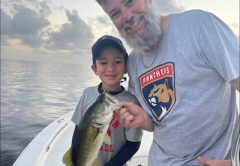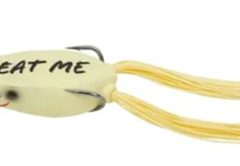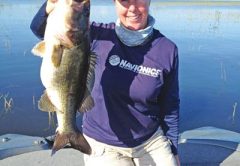Lake June-in-Winter located off of route U.S. Highway 27 in Highlands County is Highlands County’s 3rd largest lake consisting of 3,739 acres of water. This lake was once known as Lake Stearns. The lake is a kidney shaped lake with coves on the northeast and northwest side. The lake is a multi-use lake with both fishing and recreational activities such as power boating, water skiing, and jet skiing taking place.
Being on the west side of the Lake Wales Ridge, Lake June is considered to be within the Peace River Basin. The lake receives inflow from Lake Placid to the south through Catfish Creek when Lake Placid is above 93.1-ft NGVD. Lake June also receives inflow from Lake Henry which lies just to the north. With the assistance of water control structures, the water flow out of Lake June is northward through Stearns Creek into Lake Francis and eventually via Josephine Creek to Lake Istokpoga and onto Lake Okeechobee.
The south, east and north shores of Lake June are bordered by light residential neighborhoods while the entire western shoreline is bordered by Lake June-in-Winter Scrub State Park. The lake has two public parks on its shores from which power boats can be launched. The Lake June Sports Complex located at the end of Tangerine Drive is on the southern shoreline of the northeast cove and has a concrete launch with a dock and dirt parking for 20 trailers. H.L. Bishop Park located at 10 Lake June Clubhouse Road is situated across the northeast cove and has two concrete launches with docks. There is paved parking for 30-trailers and the park has other public facilities and a separate fishing dock.
Lake June-in-Winter is one of the deeper water lakes in the area with depths ranging up to 40-ft deep. Contour depths a generally slow sloping though areas like the northeast cove have quickly falling water contours. For the most part the bottom consists of sand and loom with submerged vegetation covering the shallower depths. Shoreline vegetation includes cattail, pickerelweed, spatterdock, emergent grasses, eel grass and other submergent grasses and patches of hydrilla. Water clarity is generally good though the lake can develop a greenish tint. In 2013 the lake developed an outbreak of Illinois pondweed and the FWC stocked the lake with sterilized triploid grass carp. These fish have long life expectancies and can grow quite large. They are protected by the State and cannot be harvested.
Lake June-in-Winter is a well documented FWC Trophy Catch lake with over twenty-four bass over 8-lbs being registered with the State and then released back into the lake since August 2013. The largest being an 11-lbs 3-oz prized fish taken in January 2015. In addition to largemouth bass, the lake is home to Black Crappie (Specks), Shellcrackers (Redear Sunfish), Bluegill, Bream, Pickerel, catfish, and baitfish such as shiners, shad, and Florida chubs
Lake June fishes well 12-months a year. During the spawn most anglers target the west wall that stretches along the shoreline of Lake June-in-Winter Scrub State Park. There a mixture of vegetation provides protection for bedding bass and plenty of opportunity for anglers in search of a trophy sized fish. Like most local lakes the spawn comes in waves and is driven by water temperature and the light-dark cycle. During the spawn swim jigs, spinners, soft plastics and live shiners are the preferred baits. During the pre and post spawn, the bass will hold up in the grass beds just outside the western wall and can be taken with swimbaits, crank baits, soft plastics and live bait.
During the summer pattern, fish tend to move offshore in search of cooler water and congregate at natural and man-made structures such as boat docks, drop-offs, ledges, and brush piles. During this period fish shallow in the pre-dawn morning with top water baits, crank baits and spinner baits and as the sun rises, look for schools of bait and fish holding onto structure with your depth finder. For deeper fish, Carolina rigs, Texas rigged worms, and drop shots rigs all work well. The best colors are black, junebug, watermelon red, green pumpkin and dark green.
Lake June-in-Winter offers a great opportunity to school young anglers in the various techniques of fishing. There are shoreline areas to flip and pitch to; there are shallow water areas where top water baits and soft plastics are effective; there are areas of shallow water submerged grasses that beg for swim baits and crank baits; and then there are those brush piles and underwater structures where you need to be able to use your electronic to be effective. When on Lake June-in-Winter, school is in session and a trophy bass is the guest lecturer.
Hope that helps and see you on the water.
[easy-social-share]






